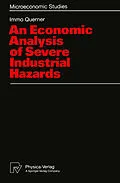and Acknowledgments Apparently almost every other month severe industrial hazards invade our living rooms, be it in terms of an ex post report or in terms of an alarming scenario, be it in a remote corner of the world or just in front of our doorstep. Although the invasion of our living rooms is mostly only via printed or electronic media (as opposed to personally experienced tragedies), people in the western hemissphere seem to be concerned, and so are politics and science. Given that welfare-economics has played (or is about to play) a helpful role in terms of analyzing and rationalizing "political" issues (such as the environment, education, or the law) that had been deemed too soft, too psychological, too value-laden, or too political, a book about the economics of catastrophic industrial hazards and their prevention will hardly come as a surprise. However, what are the precise obj ecti ves of this book? For a start, the author intends to argue the welfare-economic relevance of severe industrial hazards, both from a theoretical as well as from a very down-to-earth perspecti ve. Secondly, it shall be demonstrated that and how the problem can be theoretically dealt with, without really departing from standard micro-economics, in particular the "Pareto principle" and, when it comes to very small "collective" physical risks, the well established "von Neumann-Morgenstern" framework.
Inhalt
Nomenclature.- Nomenclature.- A: A General Model of aversion Against Severe Industrial Hazards.- I. 'Unlikeliness' of Physical Risks.- 1. The Expected Utility Approach.- 1.1. Basics.- 1.2. Assumptions.- 1.3. Properties.- 1.4. Comparison to 'Bernoulliism'.- 2. Criticism of the Expected Utility Approach.- 2.1. Basic Experimental Evidence.- 2.1.1. The Common Consequence Effect (Allais' Paradox I).- 2.1.2. The Common Ratio Effect (Allais' Paradox II).- 2.1.3. The Reflection Effect.- 2.2. From Clinical Common- to Physical Certainty-Effects.- 2.2.1. From Clinical Common- to Financial Certainty- Effects.- 2.2.2. From Financial- to Physical Certainty Effects.- 3. Vindicating EUA: Is There Really a Need to be Afraid of Russian Roulette?.- 3.1. Term Life Insurance Market.- 3.1.1. Supply of Life Insurance.- 3.1.2. Demand for Life Insurance.- 3.2. Safety-Improvements.- 3.2.1. Is Physical Safety a Normal Good?.- 3.2.2. Is Physical Safety a Drug?.- 3.3. Smith and Desvousges Re-visited.- Appendix 1 to chapter A.I.- Appendix 2 to chapter A.I.- Appendix 3 to chapter A.I.- Appendix 4 to chapter A.I.- II. 'Catastrophiness' of Physical Risks.- 1. Basic Definitions.- 1.1. A First Definition of 'Catastrophiness.- 1.2. A Definition of 'Publicness'.- 1.3. 'Catastrophiness' vs. 'Publicness'.- 2. A Generalized State-Dependent Utility Framework.- 2.1. Formalizing Heir-Dependent Bequest Utilities.- 2.2. Maximizing Heir-Dependent Bequest Utilities.- 2.2.1. A 'Lerner'-Testament.- 2.2.2. A 'Constant Bequest Ratio'-Testament.- 2.3. 'Catastrophe Aversion'.- 3. Living in the Presence of Catastrophic Hazards.- 3.1. Life-insurance Arrangements.- 3.1.1. The Supply of Life-insurance.- 3.1.2. The Demand for Life-insurance.- 3.2. Catastrophe-Reductions.- 3.2.1. Who Would Pay How Much for Catastrophe- Reductions?.- 3.2.2. Is Catastrophe-Reduction a Normal Good?.- 3.2.3. Is Catastrophe-Reduction a Drug?.- Appendix 1 to chapter A. II.- Appendix 2 to chapter A. II.- III. Likeliness vs. Catastrophiness of Physical Risks.- IV. A Liability Insurer's Risk Evaluation.- 1. The Basics.- 2. The Liability Insurer's vs. the Testator's Risk Evaluation.- Appendix 1 to chapter A. IV.- Appendix 2 to chapter A. IV.- B: A Micro-Economic Analysis of Measures Against Severe Industrial Hazards.- I. Risk Evaluation for a 'Reference Model' of Industrial Hazards.- 1. The 'Reference Model'.- 1.1. A General Lexian Framework.- 1.2. A Dichotomous Lexian Model.- 2. Individual Risk Evaluation.- 2.1. The Marginal Rate of Substitution Between ? and ?.- 2.2. The Marginal Option Price for Changes of ?.- 2.3. The Marginal Option Price for ?.- 2.4. Interdependencies of the Marginal Option Prices.- 3. A Liability Insurer's Risk Evaluation.- Appendix 1 to chapter B.I.- Appendix 2 to chapter B.I.- II. Aggregation of Individual Risk/Consumption Preference Patterns.- 1. Arriving at a Society-Wide (Marginal) Option Price under Uncertainty: The General Case.- 2. Arriving at a Society-Wide (Marginal) Option Price under Uncertainty: The Dichotomous Lexian Model.- III. Aggregate Risk-Reduction Cost.- IV. Optimal Provision of Physical Safety.- V. Market Solutions, Failures and Corrections.- 1. The 'Free Market'-System.- 2. Ex Ante Safety Regulations.- 3. Strict Liability.- 3.1. Strict Liability with Compulsory Liability-Insurance.- 3.2. Strict Liability with Regulated Compulsory Liability-Insurance.- 3.2.1. Insurance-Premia Ceiling.- 3.2.2. Corrective Insurance Taxes.- 3.2.3. A Risk-Reduction Cost Subsidy.- 3.2.4. Simultaneous Employment of Risk-Reduction Subsidies and Corrective Taxes.- 3.2.5. Corrective Compensation Standards.- 3.2.6. Regulation of Risk-Pooling.- 3.2.7. A Simultaneous Employment of Premium Ceiling, Corrective Taxes/Risk- Reduction Subsidies and Corrective Compensation Standards/Risk-Pooling Regulation.- 3.3. Strict Liability with Optional Liability-Insurance.- 3.4. Many Hazardous Facilities.- 3.4.1. The Insurance Market.- 3.4.2. The Operators.- Appendix 1 to chapter B.V.- Conclusion.- References.
